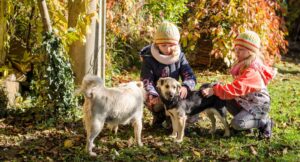Dogs and Children: Top Tips to Keep Everyone Safe

If you have young family members or dogs visiting this holiday season, here are our top tips to keep everyone safe.
1. Always supervise dogs and children
No matter how much you trust your dog around children or how well behaved and responsible the children may be, we recommend that they are never left alone without the supervision of a responsible adult.
2. Make sure children understand the signs that a dog is uncomfortable.
Teach children to leave the dog alone if they notice any signs of distress. A dog may be showing that they’re uncomfortable if they:
- Turn their head away
- Hold their ears back
- Yawn or lick their lips
- Show the whites of their eyes
- Crouch or get low to the ground
- Bare their teeth or growl
3. Set safe boundaries for everyone.
A dog or cat lying sleeping may be easily startled by a child eager to interact, or a pet may become defensive if they are eating meals or treats when interrupted.
Help children understand that animals need their own safe spaces where they can relax without the worry of intrusion.
4. Never allow children to approach dogs they don’t know
You never know how an animal will react to being approached so it’s really important to ask the owner before interacting with any dog.
If the owner is happy for you to approach their dog, it’s still vital to do so safely:
- Let the dog come to you if they want to
- Toss any treats on the floor in front of them rather than handing them directly to the dog
- Don’t reach your hand out towards a dog as this can appear threatening to them, instead give them space by keeping your hands by your sides
- Once the dog has come to you to engage in cuddles and strokes, stop for a moment to allow them the chance to show if they are enjoying it. If the dog pushes their head into you for more attention, then they’re happy to be fussed over!

5. Be respectful
As well as teaching children how to safely approach an animal and how to recognise signs of discomfort, you should also explain that pets don’t always want to play the same way as children.
Dogs and cats don’t always understand that a cuddle or kiss is an expression of love and can feel worried by this. Let them know to use gentle hands to calmly pet animals and save the cuddles, kisses, or more hands on play for family and friends rather than with pets.
6. Introduce games that children can play safely with pets.
Don’t allow young children to poke, pull or grab at a pet’s fur, ears or tail as this can hurt them and cause them to become defensive.
Try introducing interactive games like fetch, search and find, or try including older children in positive training where they can safely reward pets with yummy treats for learning new things.
7. Remember that dogs can be easily startled by strange or unusual objects
New things can be frightening for animals, so be aware that they might feel overwhelmed by any large, brightly shaped toys that Santa might have brought.
If children are using scooters or bikes make sure to give passing dog walkers lots of space, slow down, or ideally, get off and push bikes and scooters until the dog has moved past.
Even running or moving quickly or noisily can worry some animals, so the excitement of Christmas morning could put them on edge. Try to be as calm and quiet as possible when interacting with animals.
8. Teach children to be mindful of things that could harm pets.
Small toys or objects left lying around can be dangerous for dogs who are prone to chewing on things. Avoid any teddy bear casualties and emergency vet trips by explaining the danger to young children and encouraging them to tidy up after themselves.
Lots of foods can be toxic to animals such as chocolate, raisins and grapes, so make sure children know not to give any food or treats without a responsible adult present.
9. Train your dog to enjoy alone time
During a busy holiday season, it can be hard to supervise children and animals at all times or to avoid excitement levels that might overwhelm your dog. In these instances, it will be necessary to separate your dog and give them space to relax.
Help your dog to prepare for this by encouraging positive alone time, separation should never be a punishment. Give them a space where they feel comfortable and safe with access to water, a comfy spot to sleep and their favourite toys.
See our article on separation anxiety for more information on how to get your dog used to being alone.
Have fun and happy holidays!
With responsible supervision and preparation, dogs and kids can have a lot of fun playing together. Follow these tips to create a safe environment for both children and animals and let the festivities begin!